#it's shortened from loaf of bread
Note
for the kiss meme!!! hobie/pavitr, 24!!! if that's a repeat of one you already have, lmk<3
24) A kiss in danger
New York- whichever New York this is, Hobie doesn’t even remember right now- is spinning.
They land less-than-gracefully behind a dumpster, Pavitr’s swinging awkward and off-balance while supporting Hobie’s full weight. The piled bags make a halfway decent cushion as Pavitr sets him partway down, unhooking the guitar strap to move it aside before letting him fully collapse onto his back.
"Puttin' me right back in the rubbish, eh?" Hobie chuckles, pulling the bottom half of his mask up as though that'll make breathing with a few probably-cracked ribs any less painful. There’s blood seeping into the fabric from the gash where his forehead connected with brick hard enough to smash through. "I've slept in worse."
Pavitr yanks his own mask off, breathing hard, his perfect hair even a little out of sorts. His sweat-shiny cheeks flush darker with embarrassment. "Shut up, it was the closest place I could think of to hide you." He glances nervously down the alleyway, before snapping back to Hobie and kneeling “What were you thinking, running right back into the fight after that? You can barely walk straight, let alone swing or anything else!”
"Told you I was fine,” Hobie retorts, trying a bit pathetically to push Pavitr back and drag himself into a halfway proper sitting position. Everything around him still feels like it’s moving, as if he’s dipping through the sky between buildings rather than flat on his arse on the pavement. “Takes more’n a crack to the loaf to keep me out long.”
Pavitr obviously isn’t having it, and he pushes Hobie’s mask up further, lifting each of his eyelids in turn to examine his unfocused pupils, wiping away the still-seeping blood with the pad of his thumb. “How many fingers am I holding up?”
“Numbers’re a tool of capitalism…oughta abolish ‘em…” Hobie mumbles, which is definitely a real view he holds and not absolute bullshit to make up for the fact that right now he’s got no idea. Pavitr hisses something in Hindi that he doesn’t understand but that has to be a curse based on the tone alone. It's sweet that he's so worried.
Shit, he's fuckin' beautiful. Both of him.
…Alright, that's not great, maybe Pavitr's got a point. But Hobie managed to string up his universe’s Vulture last week with his eyes still stinging and watering from tear gas- whatever the villain of the week can throw at him, he’s had worse. And this one’s no fuckin’ joke- he’s not leaving Gwen and Pav to deal with it on their own. Not that he doesn’t trust them- ‘course he does, and he can’t say that for many- but he’s not about to let them be the ones to get hurt because he let himself get knocked around one too many times.
Spiderman always gets back up- nah, that’s bullshit. He doesn’t care what Spiderman is supposed to do. But Hobie Brown does always get back up, without anyone but himself telling him that he has to.
He pushes again, harder this time, and manages to get a foot and a hand under him, ignoring the wave of nausea that hits him as he starts to rise. “Alright, I sat for your li’l checkup, let’s get back innit.”
He opens his mouth to say something else, but doesn’t quite manage, on account of Pavitr grabbing a handful of the front of his suit and yanking him in for a kiss.
Surely he can blame the concussion for the way his brain all but short-circuits.
He’s…fuck, he’s dreamed about this, even if this isn’t remotely how he pictured it happening. He’d have a hundred questions right now if his head didn’t feel like it was full of rocks. As it is, all he can think is how soft Pav’s lips are, warm like sunshine- perfect, just like the rest of him. And hell, it’s such a cliche he’s almost embarrassed to think it, but it’s like time stops for those few moments, letting them breathe the same air, letting Hobie memorize the feel and the taste of him in case this never happens again.
He doesn't even notice the twinge of his spider-senses, because they've been screaming for hours as it is-
-Until a nasty crash echoes from the direction of the fight and Pavitr's lips pull away from his, and he moves to sit, to follow them- and he can't.
...Wanker's webbed him to the goddamn wall. He'd be angry if he could see straight, if he was in any fit state to tear his way free. As it is, he's a little impressed, and more than a little struck stupid by the lingering feeling of the other boy’s lips on his. Pavitr is glaring at him, nostrils flared, and now is absolutely not the time to tell him that he looks even more gorgeous pissed off like this.
"If you are too stubborn to take care of yourself, then I will do it for you,” he snaps, wiping a smear of Hobie’s black lipstick and blood- far too attractive on him, criminal really- from his mouth before pulling his mask back on, disappearing back under Spiderman’s blank white eyes. “Gwen and I can handle this, I promise. I’ll be back the moment it’s safe.” His voice sounds softer, gentler than it did a moment ago, cracking a little as the worry slips through. He sounds more like himself, he sounds...it sounds like he really cares. And yeah, they're friends- or...something now, who knows what- but Hobie's still getting used to people caring.
...Or maybe Hobie’s just starting to hallucinate. Jury’s out.
Pavitr begins a running start down the alley to web himself back into the air, only to turn awkwardly mid-step, gesturing to the dumpster. “Just- stay there, okay?” he calls back, and Hobie snorts, wheezing out a pained laugh.
As if he’s given him any choice on that.
“Oi, Pav, hang on-” he starts, struggling pointlessly, but the other Spiderman is already gone, leaving him with the rubbish and the absolute mess of his thoughts.
“...Bollocks.”
#chaipunk#goldenpunk#hobie brown#pavitr prabhakar#hobie x pavitr#spiderverse#across the spiderverse#atsv#kiss meme#concussion#pre-movie i guess#fun fact loaf means head in cockney xD#though i think that was obvious in context#it's shortened from loaf of bread#pav is still a sunshine boy but he is very capable of being mad xD
127 notes
·
View notes
Text

Cockney Rhyming Slang! ✨
I’ve seen a good amount of rhyming slang from Hobie in fics and I love to see it! I love language and slang; I find the origins and usage of words fascinating, so I thought I’d make a little post about it to offer up some knowledge, tips and suggestions that I hope will be helpful or interesting to both those currently incorporating it in fics, as well as to those who want to use it but might not know where to start. Or even to those who don’t write but want to know!
So here we go!
First, a very brief history!
Cockney rhyming slang originated from the East End of London in the early 19th century. It was originally used by Cockneys so they could speak in front of the police without being understood and was very handy if you had some dodgy dealings going on. It has since passed into common language and is no longer restricted to use by Cockneys.
So you can see why it would make sense for Hobie to know a lot of it if he’s running around rebelling against a corrupt government run by supervillains!
How does it work?
Cockney rhyming slang works by taking a word and using a rhyming phrase of about two to three words to replace it. For example: “Daisy roots” means “boots” and “Ones and twos” means “shoes”.
There can be multiple phrases used for the same word, for example: both “Trouble and strife” and “Duchess of Fife” mean “wife”.
A Cockney rhyming slang tip:
A little shortcut to make your Cockney rhyming slang more authentic to a day to day Brit is to only use the first word in the phrase. For example:
If I wanted to write “Use your head”, I could write “Use your loaf of bread” and that would be accurate, but it would be even more accurate to just say “Use your loaf”.
Another example:
“I haven’t got a clue”, which if you’ve seen Across the Spider-Verse, you would know is “I haven’t got a Scooby Doo”, is commonly shortened to “I haven’t got a Scooby”. This actually threw me off when I saw it in the cinema and I never knew why until I learned about the “first word rule” in an East End documentary the other night 😂
Other examples:
Bread and honey = money. “I don’t have enough bread for that.”
Rabbit and pork = talk. “He don’t half rabbit on”. Chas and Dave wrote a song called Rabbit, which is a bit casually rude towards women as many things from the 80’s can be, but it did give us the line “You’ve got more rabbit than Sainsbury’s“ which I find quite funny.
Butchers hook = look. “Let’s take a butchers at that”
Donkeys ears = years. “I haven’t seen you in donkeys!”
I believe that back in the day, only using the first word of the phrase was an added level of secrecy to keep the police from knowing what you were talking about since it took away the rhyming portion of the phrase which the police might have been able to guess the meaning of. Only those who knew the rest of the phrase would know what the other was talking about. It has since become a more common practice to the point where many people don’t even realise they’re doing it (as I did until recently).
However, it is still perfectly acceptable to use the full phrase. For example, I’ve called someone on the old “dog and bone” (phone) and I’ve heard the stairs be called “apples and pears” but not really just “apples”.
Other examples:
Donkeys ears = years. “I haven’t seen you in donkeys!” as mentioned above. It’s also commonly mistaken for Donkeys Years. “I haven’t seen you in donkeys years”. Although technically it isn’t the full phrase, I’d say this still counts.
Shortening and adaptations:
Over time, some of the phrases have been shortened and adapted to form new slang. For example:
Bottle and stopper = copper (police). I’ve seen a lot of use of bottle and stopper in fanfics and that’s perfectly acceptable. However, the phrase is more commonly shortened to “Bottle” or adapted to “Bluebottle” or “Mr Bluebottle” due to the colour of their uniforms. Also, “bluebottle mob” can be used to mean the police force.
Another example of shortened and adapted Cockney rhyming slang is:
“Pork pies” = lies. More commonly shortened to “Porkies”. E.g. “she’s telling porkies.”
Here are some other slang words that have their origins in Cockney pronunciation:
Wotcher - an informal greeting originating from the Cockney contraction of “what cheer” (basically meaning “hello” or “what’s up?”). E.g. “Wotcher.”
Bruv/Bruvver - brother. Used the same way one would say “bro”. Bruvver is a cockney pronunciation of “brother” which has been shorted to the more commonly used “bruv”. E.g. “Good to see ya, bruv!”
And there you go, some quick knowledge about Cockney rhyming slang! I don’t claim to be an expert on the topic, a true Cockney would know far more than I do, but I thought I’d throw my hat into the ring and share the knowledge I do have in the hopes that it will help or entertain someone.
I’ll make another post going into police specific slang terms since that seems to be something that is intrinsically tied to the Spiderman experience, as well as Hobie’s, even more so as an anarchist arachnid, fascist punching punk rebel.
I might also make another post about general British slang words. Let me know if that’s something you’d be interested in or if there’s a specific area that you’d like to know about!
#hobie brown#cockney rhyming slang#hobie brown fanfiction#hobie spiderverse#spiderman across the spiderverse#hobie brown atsv#atsv hobie#atsv fic#fic help#spider man: across the spider verse#across the spiderverse#Spiderman#across the spideverse fanfic#spider verse fanfic#spiderverse fanfic#british slang#apologies if I made any mistakes#I can only speak from my experience of being British and surrounded by other British people
446 notes
·
View notes
Text

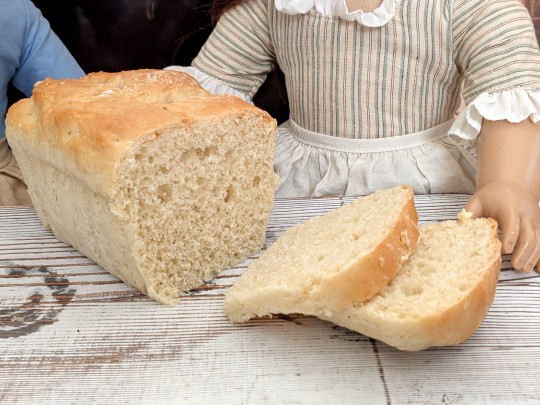
It's bread baking day at the Merriman household, and Felicity is happy to have her friend Elizabeth helping out with the tedious chore. Today they're making loaves of Sally Lunn bread, a soft and dense loaf rich with eggs and sugar, reminiscent of French brioche.
The recipe comes from Felicity's Cookbook, which I've owned for years and have used quite often. I made this bread for the very first time this week, and I was very happy with how it turned out. It's soft, flavorful, and doesn't require any kneading. As much I as I enjoyed it, I don't think it will ever be my go-to bread recipe, since it's so exceedingly rare for me to have eggs, milk, butter, and sugar in my kitchen all at the same time!
Unlike Felicity, I never learned to make bread when I was her age. When I grew up and moved out into my own place, I brought my childhood copy of Kirsten's Cookbook, and the recipe for whole wheat round bread was what got me started and helped me learn to make my own bread instead of buying it. I've been doing that ever since. I even taught my mom to make homemade bread, which had always intimidated her.
Felicity's Cookbook mentions that the origin of the name "Sally Lunn" is not known for certain. It might come from the French words "soleil-lune" which means "sun-moon", or "sol et lune" (sun and moon) due to the golden top (sun) and white interior (moon). I checked to see if this is still a mystery 30+ years after Pleasant Company published this book, and apparently it still is. The Sally Lunn Eating House in Bath, England claims that the recipe originated from a French Huguenot refugee named Solange Luyon, whose name was then Anglicized as Sally Lunn, but there's still no solid evidence of this being true either.
In the UK, Sally Lunn bread is usually made as buns, while in the American South it's a loaf made in a round or tube pan. I thought it would be cute to make it in doll-sized mini loaf pans so Felicity and Elizabeth could help.
The recipe is below the cut, with a few of my (experienced bread baker) adaptations.
Ingredients:
3/4 cup milk
1/4 cup warm water
1 package active dry yeast
6 tablespoons butter, softened
3 tablespoons sugar
2 eggs
3 cups flour
1 & 1/4 teaspoons salt
Shortening or butter to grease the pans
Here are the mini loaf pans I used. Or you can use just one standard sized tube pan or loaf pan, but the minis are cuter and in my experience the bread turns out better in small loaves.
Directions:
Measure the milk in a saucepan and warm it over medium low heat. Turn off the heat.
Measure the warm water into a small bowl. Add the yeast and stir. Then stir the warm milk into the yeast and water. Always use WARM water and milk only, NOT HOT liquids. Yeast is alive and temperatures above 140F will kill the yeast.)
Measure the butter and sugar into a mixing bowl and beat them together with a hand mixer or whisk until they are creamy and soft.
Crack 1 egg into the mixing bowl and beat it into the butter and sugar mixture until it's well blended and creamy. Then do the same with the second egg.
Stir in about 1/3 of the yeast and milk mixture into into the butter and sugar mixture, then add the salt and 1 cup of flour.
Once these are all mixed together, do the same with the second cup of flour and another 1/3 of the yeast mixture. Then do the same with the last cup of flour and last 1/3 of the yeast mixture. Mix it all together until it's soft dough with no lumps. If it feels too dry to mix, add one or two tablespoons of milk until it's soft and mixable.
Scoop 1/3 of the batter into each of your three greased mini loaf pan. Or into the single pan.
Cover the pan(s) and let the dough rise for about an hour in a warm place. On the kitchen counter is fine. Or set it in the oven but do not turn the oven on. Don't put it in the fridge or anywhere cold.
After an hour, turn on the oven and pre-heat it to 350 degrees.
Bake for about 20-25 minutes if you're making three small loaves. Keep a close eye on them and take them out once the tops are a nice golden brown, like in my pictures. If you're making a single loaf in a single pan, it will take closer to 45 minutes to bake. Keep an eye on that as well and take it out the moment the top is golden brown.
Let the bread cool off for a few minutes. It will continue to cook on the inside as it cools, so let that happen before cutting a slice with a serrated bread knife.
46 notes
·
View notes
Text
Pumpkin Bread

This is an ameliatarian adjustment of a recipe originally from @luminousalicorn. It's good!
225g (1 2/3c) all purpose flour (whole wheat also works fine)
1 tsp baking soda
1 tsp baking powder
3/4 tsp salt
1/2 tsp cinnamon
1/4 tsp nutmeg
1/4 tsp ground cloves
110g shortening or 1 stick vegan butter*
1 15oz can pumpkin
267g (1 1/3c) sugar
100g (1/3c + 1 tbsp) milk
Optional: 40g mini chocolate chips
Whisk together dry ingredients. In a separate bowl, mix wet ingredients (shortening onward) with a mixer, until the shortening is broken up into small but still visible pieces. Mix together dry and wet and fold in mini chocolate chips if using.
Put batter in a greased and floured 9x5 loaf pan.
Bake at 350 for 1-1.5 hours (my oven is a little wonky and it took me a long time).
*Do use vegan butter or shortening even if you're not vegan; it makes the texture smoother. If you are vegan, you can use any non-dairy milk to make the loaf.
7 notes
·
View notes
Text
When in doubt, BAKE! Pt. 685: Saturday Night Bread
It's been one fuck of a week again, and my world has been changed drastically, and today I said fuck it I'm gonna bake bread.
This batch is about 60-40 Whole Wheat-White, a "Whole wheat Light"...it usually makes excellent sammy bread. It has some heft, but it's not so heavy as pure whole wheat.
Not sure if I've posted about THE BOOK yet, but this is THE BOOK if you really REALLY want to get good at baking bread:



"The Laurel's Kitchen BREAD BOOK", written in 1984 as a followup to the classic Laurel's Kitchen, by Laurel Roberston, Carole Flinders et.al. Carole and Laurel were both excellent writers, and the book is a pleasure to read. It's got the typical hippie wood cuts (they were in Berkeley, after all) and is my home bread-baker's bible. They wouldn't approve tonight's loaves, which are padded with white flour. lulz. I give myself lots of fail room when I haven't baked in awhile.
The original Laurel's Kitchen was the very first vegetarian cookbook I ever read, it was 1981, I'd just moved to Houston to work in the record stores...learned a lot from that book, but one trick they used can no longer be used, and they stressed that in the Bread Book: No baking in 48 oz juice cans (which they had championed in the first book). Now they line the cans with poisonous coatings, can't use them. Which is fine with me...I like my bread square/rectangular, when I'm makin' sammies.
Started this batch with 3 cups whole wheat, 2 1/2 cups white, and a tablespoon of salt, dry in the mixer bowl. Mix on low for about a minute to mix thoroughly. Replace the paddle with the dough hook.
In a 4-cup Pyrex measure, put 2 1/2 cups luke-warm water, and in a 1 cup measure, put 1/2 cup lukewarm water.
Into that one cup, put a tablespoon of brown sugar. Put another tablespoon of brown sugar in the large measure. Sprinkle one tablepoon of dry yeast into the small measure and stir.
With the mixer on the first speed, with the dough hook, slowly pour the yeast mix into the dry ingredients in the bowl. Follow with the rest of the water/sugar.
Now start adding small amounts of white flour until it begins to "pick up" and starts cleaning the bowl. In between these additions of flour, add, about a tablespoon at a time, 2 tablespoons of softened salted butter. The dough should pick up and become quite soft after a few more minutes.
After mixing on the first speed for about five minutes with the dough hook, turn it out onto a floured countertop and finish kneading by hand.
It'd been so long since I had my hands on some warm, live dough...and it made me smile, it's such an amazing feeling to work with it in its various stages.
Once it's become a good, solid dough from hand kneading for about five minutes, form it into large ball, and put in a large crockery bowl that's been buttered. Turn the ball to coat, place a linen towel atop and place in a draft-free, warm zone. That cabinet in the spot above the fridge is perfect. After about an hour and a half, it should be lookin' good, and a finger-poke in the middle won't "fill in".


Mash it down, making sure you get ALL the trapped air bubbles out. Form it into a ball again, and put it back in the bowl, and let it rise a SECOND TIME for about 40-45 minutes tops. It should take roughly half the time of the first rise.

Mash it down the second time, and flatten in to a big rectangle, and divide it in half. Let it rest for about five minutes.


Now form into loaves and put in the long bread loaf pans, pre-greased with shortening.





Put them back above the fridge, covered, for about 20 minutes, until they are just arching above the tops of the pans.

Put them into the 400 degree oven and let them bake for 15 minutes. AFTER 15 MINUTES, TURN THE TEMPERATURE DOWN TO 350, WITHOUT OPENING THE OVEN DOOR.

Let bake for another 30-40 minutes.
Loaves are done when they have a hollow sound when tapped, much like a watermelon when ripe.


Turn out of pans immediately and cool on racks until completely cool. Brush the tops with melted butter, if you like.


This is a good everyday bread for sammies and toast. Using butter, and using the higher temp for the initial "spring" time helps give this a solidly crunchy crust, and the blend of flours gives it a very nice texture and crumb. Yields two large loaves.

Baker gets first slice slathered in softened butter.

Y'all enjoy! I'm off to stand under the hot water for a good long while.
9 notes
·
View notes
Text
Lughnasa: The Festival of Transition
Shaina Tranquilino
August 1, 2024

As the sun reaches its zenith and summer begins its slow transition into autumn, many cultures around the world celebrate the ancient festival of Lughnasa, also known as Lammas. This festival, rooted deeply in Celtic tradition, marks a significant point in the agricultural calendar and symbolizes a period of transformation, gratitude, and community.
Origins and Significance
Lughnasa, celebrated on August 1st, is named after Lugh, a prominent deity in Celtic mythology associated with the sun, light, and skill. It is believed that the festival was originally dedicated to Lugh’s mother, Tailtiu, who was honoured for her contributions to agriculture. The name Lammas, derived from Old English “hlaf-mas” (loaf mass), reflects the Christian influence on the festival, focusing on the first harvest and the blessing of bread made from new grain.
Celebrating the Harvest
At its core, Lughnasa is a harvest festival. It is a time to give thanks for the abundance of the earth and to celebrate the fruits of labor. Traditionally, communities would come together to share the bounty of the harvest, with feasts featuring freshly harvested grains, fruits, and vegetables. Bread made from the new crop of wheat was a central symbol of this celebration, signifying both the sustenance provided by the land and the communal spirit of the festival.
Rituals and Traditions
Lughnasa is rich with rituals and customs that honour the changing of the seasons and the cycles of nature. Here are a few traditional practices associated with the festival:
Harvest Feasts: Preparing and sharing a meal made from the season's harvest is a cornerstone of Lughnasa celebrations. Dishes made with freshly harvested grains, fruits, and vegetables are enjoyed by family and friends, reflecting the abundance of the season.
Bonfires: Lighting bonfires is a common practice during Lughnasa. These fires symbolize the sun’s energy and warmth, and they serve as a way to honour the light that has nurtured the crops. Dancing around the bonfire is also a traditional activity, representing the joy and vitality of the harvest.
Games and Competitions: Historically, Lughnasa was a time for community gatherings and games. Athletic competitions, storytelling, and music were integral parts of the celebration, fostering a sense of unity and shared joy.
Nature Walks and Offerings: Spending time in nature and making offerings of gratitude to the land are practices associated with Lughnasa. People might leave small tokens or offerings at sacred sites or in natural settings as a way to honor the earth and express thanks for its bounty.
Modern Observances
In contemporary times, Lughnasa has experienced a revival as people seek to reconnect with ancient traditions and the rhythms of nature. Modern celebrations often blend traditional practices with new interpretations, reflecting a growing interest in sustainable living and community-building.
Many people today celebrate Lughnasa through gatherings that emphasize local and seasonal foods, and they may incorporate rituals that honor both the agricultural significance and the spiritual aspects of the festival. Community events, farmers’ markets, and harvest festivals often feature elements of Lughnasa, making it accessible to a broader audience.
The Spirit of Transition
Lughnasa is not just a festival of harvest; it is a celebration of transition. As the days gradually shorten and the first signs of autumn appear, Lughnasa reminds us of the cyclical nature of life and the importance of embracing change. It is a time to reflect on the past season, give thanks for what has been achieved, and prepare for the shifts that lie ahead.
By observing Lughnasa, we connect with an age-old rhythm that has guided humanity through the ages, reminding us of the ever-changing dance between light and dark, growth and rest. It is a celebration of life’s abundance and a testament to the enduring power of tradition and community.
As you prepare to celebrate Lughnasa, whether through traditional practices or modern interpretations, take a moment to appreciate the seasonal transition and the opportunities it brings for reflection, gratitude, and renewal.
#Lughnasa#Lammas#HarvestFestival#SeasonalCelebration#CelticTraditions#SummerToAutumn#AncientFestivals#HarvestSeason#CommunityGathering#BonfireCelebration#GratitudeAndTransition#NatureRituals#ModernLughnasa#FestivalOfTheSun#AgriculturalTraditions
5 notes
·
View notes
Text

So, I need to share something positive on Shabbat and here it is:
This is the best banana bread recipe I have ever found. It's from a children's cookbook my stepmother gave me and it's very simple. Bake this and you will not be disappointed!
I have some adjustments though. The first is that I have always greased my loaf pan with butter and not the shortening it calls for. This has never been a problem.
The second is that sometimes I use 3 bananas, and sometimes I use 4. Again, this has never been a problem.
Happy baking guys!
13 notes
·
View notes
Text
New faces - food adventures
So, assuming care of this strange little alien was actually not the best idea you've come up with. For one, they could get sick from anything and what were you going to do? Take them to a human doctor? Give them human medicine?
First, you figured the best course of action was to find out what they could and couldn't eat. Toby's stomach grumbled and you chuckled as the kid curled their arms around it, flushing with embarrassment.
"Alright, Tobs, what do you eat? I'll try and find a substitute that might work."
"Tobs? Didn't you already shorten my name to Toby?" Toby tilted their head.
"Well yes, but this is where human nicknames get weird. You can have even shortened versions or longer versions of short names. Typically, if you're close with a group of people, you'll pick up lots of nicknames, some not even related to your name." You said, heading to your kitchen and not even looking back to see if Toby was following you. You heard the clip clopping of his hooves on the wood. "I've got nicknames like 'flower', 'maisy', 'Taco gremlin', all manner of names really." You shrugged, opening your fridge, "so, food. Do you eat fruit?" You pulled out a punnet of strawberries that you were keeping for a special occasion. This was a rather special occasion.
Toby just blinked for a minute, trying to keep up with your conversation. Were you talking too fast again? On seeing the fruit though, Toby's eyes widened, "what are those?"
"They're strawberries. Pretty fresh still," you pulled the film off and ate one yourself, passing another to Toby.
Toby took it carefully, looking it over in their hands. "Are all those seeds?" They pointed to the specks on the outside.
"Oh, yeah. They don't have any taste or anything. They just pass harmlessly through our systems. Will they be a problem for you?" You asked.
"I-I don't think so," Toby looked down, "I heard that seeds are designed to make it through digestive systems unharmed as a dispersal method. If they survive your systems, they should survive mine, right?" You smiled and nodded. Toby took a small cautious bite.
You waited. There was a moment of silence where both you and Toby held your breaths. Then the sugar kicked in and you saw it kick in as soon as Toby registered it. Their eyes widened and they looked back at the strawberry, taking another, larger bite.
You just laughed. "Like it?"
"Yes!" Toby said, "this is great! I've never tasted anything like this before."
You laughed more. "Want another one?" You asked when Toby finished their first.
"C-can I?" Toby asked, voice cautious again.
"Of course," you smiled, "all you need to do is ask." You handed them another and they ate it up. "As great as it is that you like them, we could look into what filling foods you can try. Strawberries are more of a treat."
"Well, back home, we'd have these green, leafy plants that we'd eat from. They're very cellulose based but they have plenty of vitamins in them." Toby explained, "my moth- uh- well- Mylaiha would also use some ingredients to make this thing called uh- Pola. It had to be baked and it smelled lovely when it was fresh. I'm not sure what the equivalent would be."
"Hmm, can you maybe describe what the ingredients are?" You asked, "we like to bake things too, we might have something like that."
"Well, um... there is seeds and roots that are ground into a powder. She'd mix it with some other things like water and um... well... I don't really know. I wasn't allowed to see how she made it." Toby shrunk down now.
"Seeds and roots ground into a powder?" You pondered, "that sounds like flour to me and when you mix it with water, it turns into a paste like dough. Are you describing bread?"
"What's bread?" Toby tilted their head to the side.
You smiled and pulled out half a loaf of bread from your cupboard and gave them a slice to investigate. They turned it over in their hands, squeezing it gently then ripping it a little. You just held back another chuckle at how child-like they seemed, like a toddler given play-doh for the first time, having no idea what to do with it.
"It looks different," Toby mumbled.
"It will. We tend to add other things into it like sugar, yeast, I think white bread is meant to have fortified calcium in it too." You listed off, turning to look at the ingredients list on the loaf.
Toby took a bite. You watched as they chewed, their face twisting thoughtfully. Like with the strawberries, you could see their whole thought process. First, there was confusion as they tried out the new taste and texture on their tongue, then it turned to thought as they compared it to their memory.
Finally, Toby just shrugged, raising their eyebrows and nodding. "It's alright. I think I like it. It's a bit similar to Pola."
"That's good," you nodded, "there are many different types of bread. We could try more later. Right now, let's make you a proper meal." You ruffled their hair before turning away to make something with bread. Surprisingly, Toby didn't flinch away at the contact like you'd expected. If anything, you thought they leaned in a bit.
< Previous
Next >
43 notes
·
View notes
Text












National Hoagie Day
Load up a soft or crispy bread roll with your favorite toppings, like meat, lettuce, tomato, and mustard, and dig in. Just don’t forget the napkins!
Everyone loves food! Which might help to explain why it’s possible to find so many different food-themed days to celebrate throughout the year for anyone who wants to. So it’s not much of a surprise that this very special sandwich would get its own day too!
Whether it is known as a hoagie, a sub, a wedge, a hero, Italian sandwich or a grinder, today is the perfect day to celebrate everything you love about this overstuffed, tasty and savory treat.
History of National Hoagie Day
The humble hoagie first appeared on the plates of Americans around or soon after 1953, when the sandwich was first made in the Philadelphia shipyards from WWI.
At the time, Italians working in the shipyards would make a sandwich by putting meats, cheese and lettuce in a soft baguette-shaped roll and bring it to work with them. The story goes that this easy-to-make but delicious creation would soon be labeled with the nickname of ‘the Hog Island’. Then, maybe because it doesn’t quite roll off the tongue easily, it would soon be shortened to “hoggie” and then eventually would become known affectionately as the ‘hoagie’.
There’s also a second theory of the hoagie’s birth, where the sandwich is said to have been created by street food vendors who were known as ‘hokey-pokey men’ in the early 20th century. Supposedly, these food sellers would slice a long loaf in half and stuff it with antipasto salad before selling it as a filling snack. And perhaps they were also dancing the “hokey-pokey” at the same time?!
Well-known in Philadelphia, the hoagie sandwich is so enjoyed in the city that, in 1992, the mayor Ed Rendell declared that the hoagie should be considered the official sandwich of the city.
National Hoagie Day Timeline
1762 Sandwiches are invented
The Earl of Sandwich, John Montagu, asks for roast beef to be served between two slices of bread so he won’t have to get up from his work (or from gambling, depending on how the story goes).
1901 Submarine sandwich is invented
A small Italian grocer in New Jersey sells sandwiches on long bread that he will eventually name “submarine” sandwiches because of the shape.
1950s Hoagie sandwiches make their debut
In Philadelphia, after WWII, Italian immigrants who work on Hog Island bring long roll sandwiches with them. “Hog Island sandwiches” may have been shortened to “hoggies” and then to “hoagies”.
1955 Hoagies are listed on menus
With its growing popularity, restaurants in Philly begin to list hoagie sandwiches on their menus and it spread from there.
1992 Hoagie is made official in Philadelphia
Mayor Ed Rendell declares the Hoagie as the official sandwich of the city of Philadelphia.
How to Celebrate National Hoagie Day
Observing National Hoagie Day can be enjoyable for almost anyone when trying out some of these tips:
Enjoy a Hoagie at a Restaurant or Deli
Hoagies make the perfect lunch! In fact, that was their original purpose as they were used as an easily packable meal by the shipyard workers. So even if there’s not a lot of time for going all out in celebration, it’s easy to give a nod to National Hoagie Day by enjoying a grab-and-go sandwich lunch at a local deli.
Learn About Hoagies
Try out some of these fun facts to impress coworkers or friends for National Hoagie Day:
The perfect hoagie roll was invented when Bucelli’s Bakery joined forces with DePalma to create a delicious 8-inch long roll, which eventually became the standard for hoagies.
Americans eat more than 300 million sandwiches each year, many of which would classify as hoagies!
Premium hoagies can be made with upscale ingredients, such as imported Italian lunch meats, prosciutto, gourmet cheeses and more.
One of the biggest mysteries that seems to surround hoagies is the questions about what makes them different from other sandwiches like subs, heroes and grinders. But honestly, there isn’t much of a difference and they are basically the same sandwich just going by a different name.
Make a Homemade Hoagie Sandwich
It seems only right and good to celebrate hoagie day by fixing up a delightful and delicious homemade hoagie for yourself and those you love!
Start by slicing a soft or crispy long bread roll, throw in some favorite cold cut slices and don’t forget to add the cheese. For those who want to be fully authentic, don’t put mayo on there but, instead, stick with good quality olive oil and some Italian herbs. Finish off with some tomato and lettuce for a bit of extra crunch.
And for those who really want to get serious about National Hoagie Day, why not bake your own bread to craft your artisanal sandwich with? Fresh bread is certainly best.
Visit the Birthplace of Hoagies
Those who are super in love with hoagies might just find that National Hoagie Day is best spent in the city of Philadelphia, the place where hoagie sandwiches were first created. Some of the best and most famous Philly hoagie shops include:
Antonio’s Deli. Located in south Philly, Antonio’s serves its sandwiches on freshly baked bread from Sarcone’s, a fifth generation Italian bakery. They even serve a non-traditional vegetarian option.
Cosmi’s Deli. Operating since 1932, Cosmi’s offers more than a dozen different hoagie options on their menu, as well as cheesesteaks and roast pork sandwiches.
Liberty Kitchen PHL. With a small but delicious hoagie menu, Liberty in Fishtown offers sandwiches with hand-stretched Caputo mozzarella and other sought after gourmet ingredients.
Datillo’s Delicatessen. For more than 40 years this deli has been offering up tasty hoagies, including their house specialty that includes hot capicola, pepperoni, salami, provolone cheese, artichoke hearts and homemade roasted red peppers.
Share National Hoagie Day
Don’t keep the joy of the hoagie all to yourself. Snap a pic and share that tasty creation on social media, so other observers can join in on the fun. And perhaps it might be fun to invite some friends over for a hoagie making party. Or create a hoagie sandwich making line in the breakroom at work.
Simply line up the ingredients, including artisan bread rolls, gourmet cheese options, lunch meats and veggies, and let people pile them on as high as they like. Add some condiments such as mayo, herbs and spices, or olive oil and everyone can enjoy what they love!
Have a great hoagie day!
National Hoagie Day FAQs
What is National Hoagie Day?
National Hoagie Day celebrates the long bread sandwich filled with meat, cheese, lettuce, tomato and seasonings.
When is National Hoagie Day?
National Hoagie Day is celebrated annually on the 5th of May.
How to celebrate National Hoagie Day?
On this day, it’s best to eat a hoagie, share one with friends, or even take a trip to Philadelphia to enjoy a hoagie!
Are hoagies Italian?
Hoagies are believed to have originated from Italian immigrants living in Philadelphia.
Source
#Cowboy Burger#Hot Mushroom Sandwich#Sheepherder Sandwich#Moab Melt#Hero Panini#Hot Sausage Po'Boy#street food#restaurant#Cubano Sandwich#Classic Cheesesteak#Grilled Steak Sandwich#National Hoagie Day#5 May#fries#USA#travel#summer vacation#summer 2022#food#national day#NationalHoagieDay#original photography#vacation
2 notes
·
View notes
Note
What's your favorite or most interesting etymology???
i could do the basic etymologist orange but thats reaaallly complicated and also would get me into fights over the internet. i'll instead choose lord! it's a shortening of early forms of loaf and ward(en), and we know that because of an old english poetic form that survives in only one piece of literature!
English n. lord 'the head of a household, almost always male; a king, a ruler, a master' is found earlier as Middle English n. lord(e, lort(e, lhord(e, lourd(e, louerd(e, louered(e, lowerd(e, lowered(e, loverd(e, lovered(e, hlouerd(e, hlouered(e 'id.' and even earlier as Old English n. hlaford, hlabord, hlaferd, hlafurd, hlauurd 'id.', collapsed form of Old English n. hlafweard* 'id.' (hapax, attested in dat. sg. hlafwearde as a poetic form), a construction from Old English n. hlaf, hlæf, laf, læf 'bread; loaf' and Old English n. weard 'a watchperson, warden, guard'; the former reflects Proto-Anglo-Frisian n. *hlaif 'id.' (whence Old Frisian n. hlef 'id.'), from Proto-West Germanic n. *hlaib 'id.' (whence Old High German n. hleib, leib, leip 'id.'), from Proto-Germanic n. *hlaibaz 'id.' (whence Old West Norse n. hleifr 'id.', Old East Norse n. lever 'id.', Gothic n. hlaifs, hlaibs 'id.'), probably of substrate origin; the latter reflects Proto-Anglo-Frisian n. *wærd 'id.' (not in Frisian), from Proto-West Germanic n. *ward 'id.' (whence Old Saxon n. ward 'id.', Old High German n. wart 'id.'), from Proto-Germanic n. *wardaz 'id.' (whence Old West Norse n. varðr 'id.', Gothic n. wards* 'id.' (in daurawards 'door-guard, gatekeeper, porter')), from Proto-Indo-European n. *wortós 'id.', o-grade extension of Proto-Indo-European r. *wer- 'to watch, cover, keep guard over; to notice, see, be aware of' (whence, ultimately, English guard, warden, aware, revere, regard, and so on).
#the orange part of the post is a callout#no it isnt fucking norange where are u finding “norange”#it was in italian when the n- was lost#un narancia -> un arancia#its well attested
13 notes
·
View notes
Text
72. Baking therapy on a budget Ft. Genshin Characters: Yanfei- Almond Apple Bread

Hello, every birdy. Today we are going to make something that is become one of my favorite things to do. Bread baking. Today’s recipe is a combination between Betty Crocker’s White Bread Recipe and the Sweet Roll Recipe. And to that, I added some apples and almonds.

Yanfei is a lawyer from Liyue. She is the character that I choose for this recipe. Her favorite food is anything with tofu in it. Obviously, right now, I don’t have any access to tofu. And I realize that Yeast Bread and Tofu are not exactly the same. But, in a sense, they are (somehow). I mean they both soak up flavors.

For this recipe you will need:
2 packets active dry yeast
¾ cup warm water (105 to 115℉)
2 cups lukewarm milk (scalded then cooled)
1/3 cup sugar
1 egg
3 tablespoons shortening
1 tablespoon salt
7 to 8 all-purpose flour
Margarine or butter softened
1 cup diced almonds, in a food processor
1 or 2 apples grated
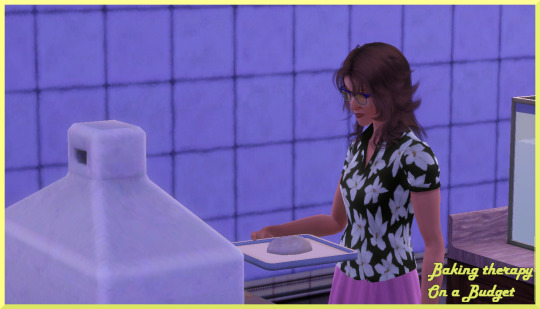
The first thing you want to do is dissolve the water in warm water, in a large bowl. Let it sit for 5 minutes so that it can bloom.

Heat up your milk, sugar, shortening, and salt in a pot just until the milk becomes blood temperature. Meaning when you place your finger in the pot, you can’t feel the temperature. It is essentially the same temperature of the blood in your finger.
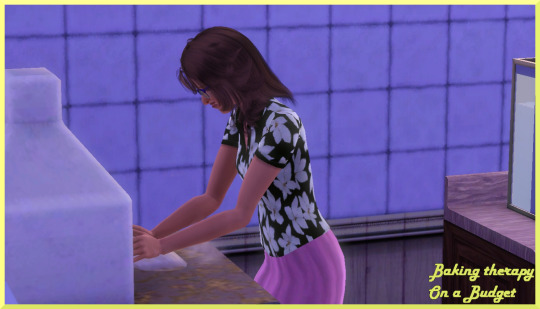
Add the milk mixture to the yeast, and add 4 cups of your flour. Beat it until smooth. Mix in enough of the remaining flour to make the dough easy to handle.
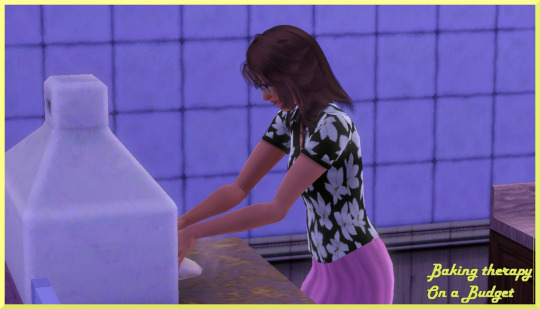
Now on to the fun part of making bread. Yes, you could use a standing mixer fitted with a dough paddle, but that defeats the therapy part of beard baking. You will want to turn your dough into a lightly floured surface and knead for 10 minutes. Until it is smooth and elastic. Place the dough into a greased bowl. Let it rise in a warm place until it doubles in size for about 1 hour.
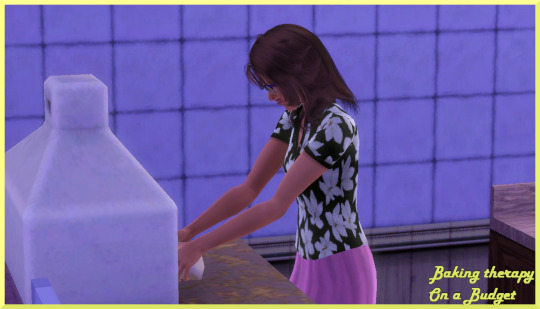
While it is proofing you can start on your filling. You are going to grind up your almonds in a food processor. For some reason, I did not add my apples to the food processor, which I really could have done. De-cored them and just tossed them into the almonds. But no, I decided to shred the apples the old-fashioned way, with a shredder. And I place both of them in a bowl. Added a little bit of cinnamon and nutmeg, to taste.

After an hour, you are going to punch the dough down and divide it in half. You are going to add your apple-almond mixture to the rolled-out dough, and then you are going to roll up the bread like you would if you were making a roll cake. Pinching all of the sides so that none of the insides come out.
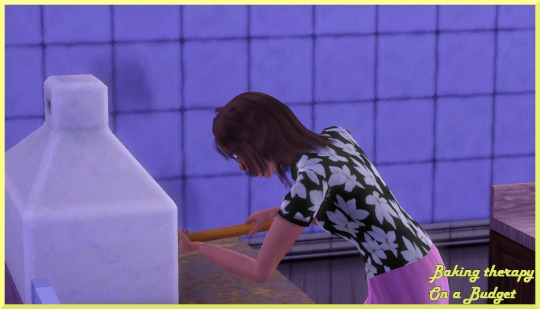
Place the loaves into the prepared loaf pans, and let the proof for another hour in a warm spot.

While they are proofing for the second time, you will want to start to preheat your oven to 425F.

Once the hour is over with, the bread is noticeably larger. You are going to bake the bread for somewhere between 25 to 30 minutes, or until the loaves have a deep golden brown color, and sound hollow when tapped.

Now that they are out of the oven, you are going to carefully take them out of the pans. And enjoy.
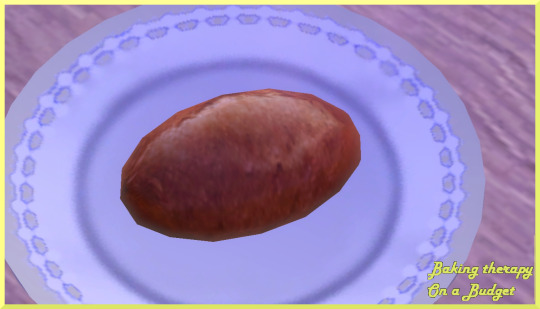
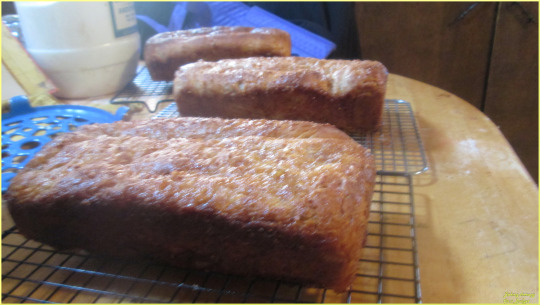
Breakfast is one of the hardest meals in my family. It’s not that we don’t eat breakfast, but it is just hard because we have to eat. And sometimes, some people have a sweet tooth, and other times people wake up and need protein. Most mornings are just getting your own breakfasts. I mean it makes sense because we are all adults. One thing everyone has in common though, is they like it when I make something like this. Because it makes breakfast easy. They can just grab whatever I have made, and if they need protein they will just add an egg. So I have unofficially been in charge of breakfast for my family.
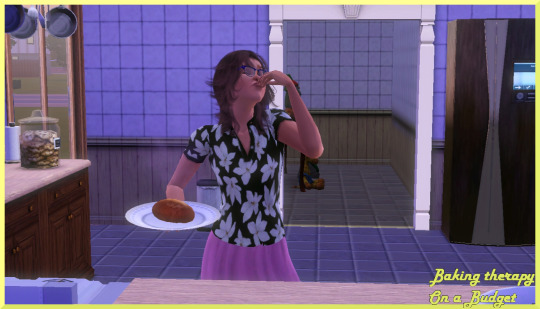
I hope that you liked this recipe. Feel free to check it out for yourself. See you in the next post. Thank you.
Pinterest: Here
Recipe:
#ts3#simblr#ts3 simblr#baking#baking therapy#recipe#food#Genshin Impact#genshin impact#yanfei#genshin#Betty Crocker#White Bread#Apple#Almond
16 notes
·
View notes
Note
me seeing your bread tags for Beatrice, Lilith and Ava 👀
also me having written a few stories where Ava made sandwiches with croissants 👀 and one where Lilith heats up a croissant by the fire for Ava 👀
do people not use croissants as bread ???
listen i’m no expert and i literally cannot express how much respect i have for the practice of microwaving a croissant with ham & extra butter inside and then eating the dripping mess with bare hands
but my understanding is that a croissant is a pastry, not a bread. it’s made with a pastry dough, and while yes a baker can make croissants, they’re in the same food genre as pies, quiches, tarts, turnovers, etc.
having made bread (i bake an excellent braided loaf 😌) that sort of dough is differentiated from pastry dough because in most cases bread contains relatively little fat (just some oil usually unless it’s brioche which is sweet bread but that’s different from pastry anyway & as i would say to my students “beyond the scope of this class”), whereas pastry contains a good source of fat or shortening to give that flaky puff-pastry texture to patisserie like croissants. in pastry i’m looking for lamination & in bread i’m (typically) looking for rise. i’m looking for crumb as opposed to flake.
so a croissant is not technically a bread, though it is powerful and can still accomplish bread things.
#please god don’t let actual experts descend upon me#i am 👀👀 at the ‘lilith heats up a croissant for avs’ gayass behaviour to heat up food for a girl#i want to read it 🥺#i am actually a great baker but tell noone#breadposting#anon
2 notes
·
View notes
Photo

Hark! Another loaf of rye bread!
This is only the second time I’ve tried this particular recipe. My first attempt was very much a fail loaf. Delicious, but fail.
This is the recipe in question:
Scandinavian Rye Bread
1 1/4 cups beer
1 egg
3/4 tsp salt
1 tbsp molasses
2 tbsp packed brown sugar
1 tbsp shortening or vegetable oil
1 3/4 cups all-purpose or bread flour
1 cup rye flour
1 tsp orange zest
1/2 tsp anise seeds
1/2 tsp caraway seeds
1/2 tsp fennel seeds
1 1/2 tsp bread machine yeast
Measure ingredients into the bread machine in the order recommended by manufacturer. Cook on basic (white bread) cycle.
(Recipe is from 250 Best Canadian Bread Machine Baking Recipes by Donna Washburn and Heather Butt)
So... what did I try changing to get a loaf that would hold together better? One thing I noticed is this recipe uses a good bit more rye and less white flour than most of the other recipes in this cookbook. Most of the rye recipes only call for 1/2 cup (or less) of rye and between 2-3 cups of white. At the time of the prior attempt I noticed how the dough was more like a batter after the initial mixing cycle (rye does tend to make muddy doughs). I decided to decrease the rye and increase the white, so for this loaf I tried 2 1/4 white to 3/4 rye. Left the yeast measurement as-is since I didn’t want to tweak too many things at once. I also let the bread cool in the pan briefly before turning it out.
The loaf came out okay (and is still delicious), but it still has some minor problems, including:
the loaf has good loft (yay), but the top was noticeably springy/spongy before turning out, and as the loaf cooled the top and sides sucked in. Both are signs of the bread having over-risen iirc, so it probably needs a little less yeast for a denser crumb; most of the rye recipes call for 1 1/4 tsp so I’ll try that instead next time.
There’s a visible (small) amount of flour that didn’t mix in properly, and has left some ugly patches of partially moistened flour on the surface and in little inclusions at that end of the loaf. Since my change to the flour ratio added 1/4 cup more flour in total to the loaf, that’s most likely the cause, and I should instead try 2 cups white to 3/4 rye to maintain the original total quantity.
5 notes
·
View notes
Text
LotR Marathon
I've never seen the LotR movies or read the books so I figured it's about time. My mom has always loved the books and kept trying to get me to read them. I read The Hobbit in 4th grade, then could not get through The Fellowship of the Ring, but decided to give it another shot now, so I re-read The Hobbit and read the entire trilogy, and I really enjoyed them! After that, we watched all of The Hobbit movies, and are now planning to marathon all of The Lord of the Rings movies (extended editions) with friends, and 7 hobbit meals (all vegetarian). We made most of the food ahead of time and froze it so there will be very little cooking the day of. Our planned date got postponed because we caught covid but we're hoping to do it soon!
Edit now that we did it! : I updated with a few changes based on what we actually did. In total, it took us about 13 hours with all the breaks for food. We were exhausted by the end and so stuffed, but we made it and had a great time!
1. Breakfast: Full English Breakfast (veg British style Baked Beans, vegan sausage, vegan bacon, fried eggs, sauteed mushrooms, pan fried tomatoes, toast)
2. Second Breakfast: Lembas
3. Elevenses: Potato Soup for Sam (omit the bacon or use veg bacon)
4. Luncheon: Pork Pies (to make it vegetarian: for the meat we used 3x Impossible beef and 1x Lightlife Sausage since Impossible sausage has garlic powder and someone coming couldn't have garlic, for the dough we used vegetable shortening, and for the jelly we used agar agar and veg broth)
5. Tea: Seed Cake, Beorn's Honey Cakes (made this into two small loaf cakes instead), also bought mini scones from Wegman's (Vanilla, blueberry, and orange cranberry) and served with clotted cream and jam (raspberry and orange marmalade)
6. Dinner: Tom Bombadil's - "yellow cream and honeycomb, and white bread, and butter; milk, cheese, green herbs, and ripe berries gathered" - we set out all of these, clotted cream as "yellow cream", butter, bread, 4 different cheeses (blueberry vanilla goat cheese, red dragon cheddar, "bree", and coastal cheddar), blueberries and raspberries, basil, sage, rosemary, thyme, and milk.
7. Supper: Farmer Maggot's - "a mighty dish of mushrooms and bacon" (used vegan thick cut bacon found here, fell apart a lot but still tastes good)
2 notes
·
View notes
Text
27. Ṣankyal

Ṣankyal [ˈʂɐŋ.kjəl], pl. ṣnkyalr [ʂŋ̍.ˈkjɐ.ɫɾ̩] means “bread” or “loaf.” It is a shortening of the earlier form folṣankyal [fol.ˈʂɐŋ.kjəl], from the proto-Mindutme phrase *fɔːlsiamki ɑl “shaped food.”
The word al “food” once meant “bread” specifically and later became more general in its meaning. This shift had already occured by the time the Mindutme writing system was first developed, which originally represented [ɑ] as a bowl of food:

To distinguish “food” from “bread” the participle *fɔːlsiamki was added for the latter meaning, referring to the process of kneading and then shaping a loaf. The participle itself is ultimately derived from *fɔːl “person,” via the suffix *-si, used to mark class 5 (natural inanimate) nouns. The original meaning of *fɔːlsi (now fulṣi [ˈfuɭ.ʂɨ]) was “corpse” or “body,” but its meaning also generalized to refer to the shape or form of any being or object, living or dead. The verb fulṣam [ˈfuɭ.ʂəm] means “to shape,” from *ɑm “to give” (we saw a similarly derived word way back on the second of Lexember). Finally, the present participle marker *-ki (also seen here and here) is added: *fɔːlsiamki, or in modern Mindutme, folṣanqe [foɭ.ˈʂɐɴ.qɛ] “shaped” (shown below).

2 notes
·
View notes
Text
How to Season and Maintain Your Cast Iron Loaf Pan with Lid
If you are a bread lover, a cast iron loaf pan with lid is an indispensable implement for your kitchen. This oven style is not only ideal for even baking of a nicely done bread loaf, but it also makes possible a well-crisped crust and a soft moist middle section. Aside from that, to avoid missing out on the benefits of cast iron bread pan, it is vital to season and preserve it nicely. This blog post is meant to guide how to season and maintain so that you enjoy your oven-baked breads for over a decade.
Why is Seasoning Important?
The process of seasoning cast iron cookware is just as important as watching what you eat. Seasoning prevents rust and makes it non-stick. During the seasoning of a cast iron loaf pan, you make up a layer of oil or fat liquid that adheres to the pan's surface. This oil coat protects from water seeping inside and prevents food from sticking, thus leading to less wastage. In addition, seasoning is a good way to enhance the taste of your bread, especially the more you use the pan. The pan will develop naturally a patina the more you use it.
How to Season Your Cast Iron Loaf Pan
Seasoning your rustic cast iron loaf pan is a simple affair that can be done with just a few basic tools and materials. Here's what you'll need:
Your 10-inch cast iron loaf pan with lid

Vegetable oil or shortening in a melted form.
Napkins or a clean cloth
An oven
To season your pan, follow these steps:
Set the temperature of your oven to 350°F (175°C).
Wash the loaf pan under running warm tap water, add liquid dish soap, and dry it properly
It's best to simply rub vegetable oil or shortening onto the pan's entire surface using a piece of kitchen paper or a clean cloth.
Place a hot pan with the lid inside the preheated oven. Then bake it for 1 hour.
Remove the pan from the oven, wait for a while and then let it cool down inside.
Once your pan has cooled, you may serve it immediately. When the skillet is almost black and has a good shine, it tells that seasoning is almost finished. This will only occur if the process has been effective.
Maintaining Your Cast Iron Loaf Pan
That explains why your cast iron loaf pan is very fragile and requires you to clean it up after every usage so as to keep it spick and span. After each use, follow these steps:
Let the pan be cooled as much as possible before rinsing.
Clean off the pan with warm water and a soft bristle brush or sponge. Around grease, it is not ideal to use soap as that will cause the skillet to lose seasoning.
Gently pat the pan dry with a dry towel or paper towels, be careful not to scratch it.
Take a piece of paper towel or clean cloth and apply a thin layer of vegetable and shortening oil or melt it to the pan.
Unless you need the exposed parts of the pan, please do store it in a dry place.
Conclusion
A cast iron loaf pan with a cover (the cover is well taken care of and seasoned well) is a very useful piece of equipment in the arsenal of a bread baker or a person who is very concerned with baking bread (a 'bread maven' or any other fan of bread). By scorching your pan and practicing handling it well, your baking skills will improve so that you will be able to make the resulting loaf taste great all the time.
At Crucible Cookware, we offer a wide range of cast iron cooking essentials, including bread pans and other cast iron cookware items, that help you make lip-smacking dishes at home.
0 notes